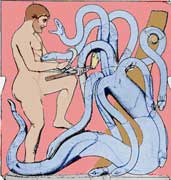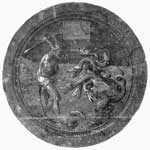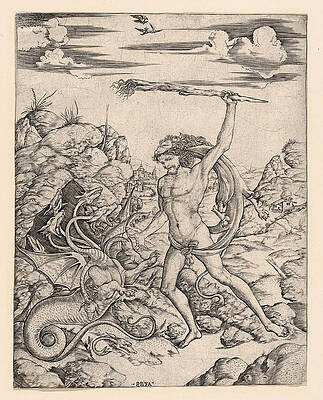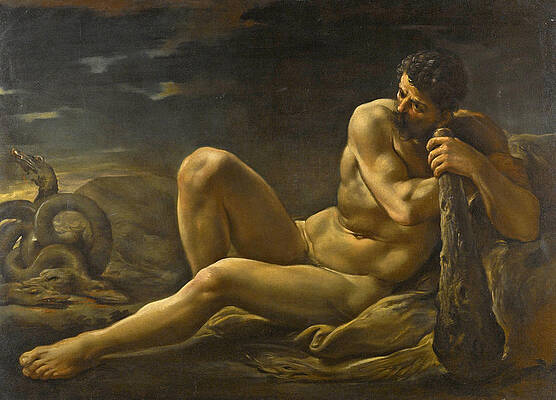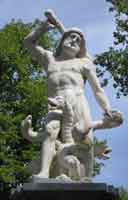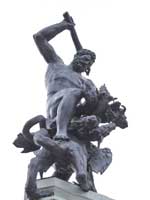.
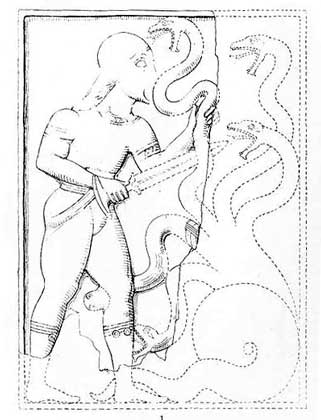
Archaic Ivory Plaque, Hercules and Hydra , Laconia.
In Greek mythology, the Lernaean Hydra (Λερναία Ύδρα) was an ancient nameless serpent-like chthonic water beast that possessed numerous heads—the poets mention more heads than the vase-painters could paint—and poisonous breath (Hyginus, 30).
The Hydra of Lerna was killed by Heracles as one of his Twelve Labours. Its lair was the lake of Lerna in the Argolid, though archaeology has borne out the myth that the sacred site was older even than the Mycenaean city of Argos, for Lerna was the site of the myth of the Danaids. Beneath the waters was an entrance to the Underworld, and the Hydra was its guardian (Kerenyi 1959, p. 143...)
In Greek mythology, The Lernaean Hydra was a snake-like beast that possessed nine (usually nine, it ranged from five to one hundred) heads and poisonous breath, killed by Heracles as one of his Twelve Labours.
The Hydra was the offspring of Typhon and Echidna, noisome creatures of the Goddess who became Hera. It was said to be the sibling of the Nemean Lion, the Chimaera and Cerberus. As such, it was said to have been chosen as a task for Heracles so that Heracles would probably die.
The Second Labour of Hercules: The Lernaean Hydra
Upon reaching the swamp near Lake Lerna, where the Hydra dwelt, Heracles covered his mouth and nose with a cloth to protect himself from the poisonous fumes and fired flaming arrows into its lair, the spring of Amymone, to draw it out. He then confronted it, wielding a harvesting sickle in some early vase-paintings; Ruck and Staples (p. 170) have pointed out that the chthonic creature's reaction was botanical: upon cutting off each of its heads he found that two grew back, an expression of the hopelessness of such a struggle for any but the hero, Heracles.
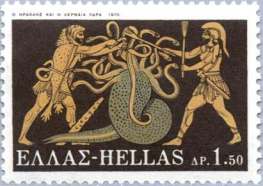
Hercules and Iolaus
The details of the confrontation are explicit in Apollodorus (2.5.2): realising that he could not defeat the Hydra in this way, Heracles called on his nephew Iolaus for help. His nephew then came upon the idea (possibly inspired by Athena) of using a burning firebrand to scorch the neck stumps after decapitation, and handed him the blazing brand. Heracles cut off each head and Iolaus burned the open stump leaving the hydra dead; its one immortal head Heracles placed under a great rock on the sacred way between Lerna and Elaius (Kerenyi1959 p 144), and dipped his arrows in the Hydra's poisonous blood, and so his second task was complete.
In an alternative version, Hera's crab was at the site to bite his feet and bother him, hoping to cause his death. Hera set it in the Zodiac to follow the Lion (Eratosthenes, Catasterismi)
When Eurystheus, the agent of ancient Hera who was assigning to Heracles The Twelve Labours, found out that it was Heracles' nephew who had handed him the firebrand, he declared that the labour had not been completed alone and as a result did not count towards the ten labours set for him. The mythic element is an equivocating attempt to resolve the submerged conflict between an ancient ten Labours and a more recent twelve.
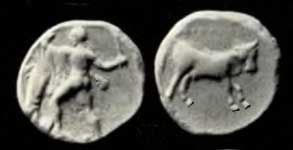
Aegina, Stater, Heracles and the Hydra, Bull, Text : "Phaistion"
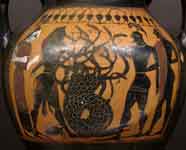
After the Hydra
In another version , Heracles defeated the Hydra by remembering the words of his wise teacher, Chiron, who had said, "We rise by kneeling; we conquer by surrendering; we gain by giving up." All his other weapons having failed, Heracles remembered his mentor's words and knelt down in the swamp and lifted up the monster by one of her heads into the light of day, where she began to wilt. Heracles then cut off each of her heads, dipping his arrows in the Hydra's poisonous blood at the same time. However, none re-grew. After he had severed all nine heads, a tenth one appeared; Heracles recognised this as a jewel and buried it under a rock.
Heracles later used an arrow dipped in the Hydra's poison blood to kill the centaur Nessus; and Nessus's tainted blood applied to the Tunic of Nessus eventually killed Heracles himself.
Today "Hydra-like problem" or "hydra" refers to a multifaceted problem that seems incapable of step-by-step solution, or to one that worsens upon conventional attempts to solve it, for example, attempts to suppress a particular piece of information resulting in it being disseminated even more widely.
Origin
When the sun is in the sign of Cancer, the constellation Hydra has its head nearby. Also close by, beneath the sun, is the constellation of Cancer, the crab. Mythographers relate that the Lernaean Hydra and the crab were put into the sky after Heracles slew them.
It is uncertain as to what the cauterising of the snake heads means, but it may derive from tales concerning a battle connected to Lerna, possibly indicative of setting fire to parts of the enemy (possibly the corpses) so as to disperse them.
Lerna features in another myth as a fountain from Poseidon created in memorial of the daughter of Danaos (who represents the Danae, who appear in earlier works, such as the Illiad, as a seafaring group from elsewhere), which may be a myth of a failed attack on the native population by Danae, which the Danae later repeated successfully.
The Greek word for arrow, which is toxon, is closely related to the Greek word for poison, which is toxis, thus the poison arrows that Heracles created from the Hydra's blood. Associations with the Nemaean lion may derive from recreating the surrounding narrative to suit an order in which the tale of the Hydra follows that of the lion.
Lernaean Hydra Louvre CA598
Hercules and the Hydra, Antonio del Pollaiuolo
Hercules Fighting with the Lernaean Hydra, Francisco de Zurbaran
Hercules and the Hydra, Cristofano di Michele Martini
Hercules and the Lernaean Hydra, Ubaldo Gandolfi
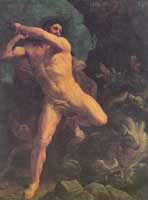
Heracles and the Hydra, Guido Reni

Gustave Moreau: Heracles and the Lernaean Hydra, 1876
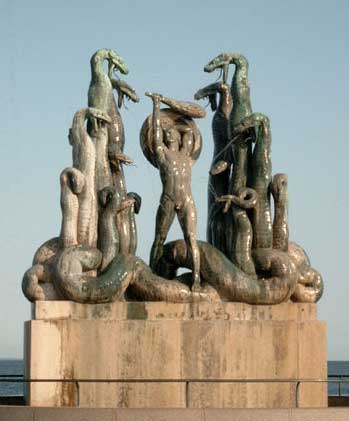
Heracles and the Hydra in Helsingør Denmark
Images
The Lerna marshes, where Herakles fought the Hydra
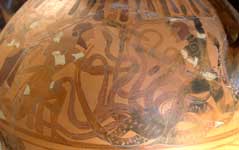
Lernaean Hydra Louvre E851
Hercules Fighting with the Lernaean Hydra, Francisco Zurbaran
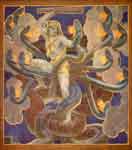
Hercules and the Hydra, John Singer Sargent
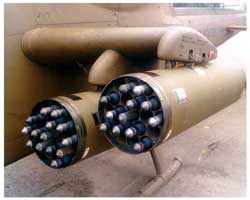
Like the Hydra with many heads, the Hydra 70 Rocket
Literature
Harrison, Jane Ellen (1903). Prolegomena to the Study of Greek Religion.
The Greek Myths: The Complete And Definitive Edition, Robert Graves
The Heroes of the Greeks, Carl Kerenyi
Greek Religion, Walter Burkert
Ruck, Carl and Staples, Danny (1994). The World of Classical Myth.
See also : Greek Mythology. Paintings, Drawings
| Ancient Greece
Science, Technology , Medicine , Warfare, , Biographies , Life , Cities/Places/Maps , Arts , Literature , Philosophy ,Olympics, Mythology , History , Images Medieval Greece / Byzantine Empire Science, Technology, Arts, , Warfare , Literature, Biographies, Icons, History Modern Greece Cities, Islands, Regions, Fauna/Flora ,Biographies , History , Warfare, Science/Technology, Literature, Music , Arts , Film/Actors , Sport , Fashion --- |
Retrieved from "http://en.wikipedia.org"
All text is available under the terms of the GNU Free Documentation License

